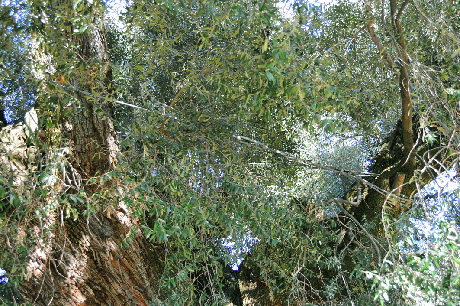|
Along the road that leads from the square of Canneto Sabino to the
nearby village of Talocci, after passing the cemetery, you will find
on your right: u livone (so it is affectionately called by the
Cannetari) a huge olive tree, beautiful in a nutshell: a patriarch
of nature. With its squat and gnarled trunk measuring in the narrow
part 5,50mt and 7,20 in the part on the ground of circumference and
a height of about 15,0mt, it stands so imperious over all the
vegetation that surrounds it to leave the visitor for a few seconds
without words. The Bertini brothers, owners since 1850 of the plot
of land where this monumental tree is located, date the same age as
2000/2100 years ago and this thanks to the test (carbon 14) made by
experts in the field. In reality there are two theses related to the
age of this tree. The first thesis is very presumably more logical
and sets in about 2000 years the age based on the fact that at the
time of Numa Pompilio, emperor of Rome but Sabinus of birth, in
order to increase the production of olive oil that was widely used
for the night lighting of Rome itself, we proceeded to a very
capillary and large-scale cultivation of olive trees. At the time
the whole of the Sabina was an area with a very high agricultural
development due to important factors such as the presence of Roman
villae and the low cost of labor due to the use of slaves and it is
therefore likely that this centuries-old olive tree existed from
those times and that it has developed in such large dimensions for
reasons of which even today the origins are not known. The second
thesis that fixes the age between 1000 and 1300 years is linked to
the name of Tommaso da Mauremme who arrived in Farfa from Jerusalem
around 700 AD, he worked so that the olive groves in the area,
destroyed by the Longobards together with Abazia di Farfa , they
underwent a rebirth; in fact, he was responsible for the
reconstruction of Farfa and all the agricultural limintrofo, the
deforestation in favor of the olive groves and the process of new
grafts on existing plants. If we add then that the Bertini brothers
bought the land from the Abbey of Farfa that until then had been the
owner, it is very credible that this olive tree, owes its enormous
growth to some miraculous grafting and therefore has had a second
life starting from 700dc.
|
|
The olive production of this tree is consolidated on an average of 8
quintals pro season but, there have been years, when it has also
reached 13ql; in 2008 the total was 10.2 ql. of olives. At the
beginning of the spring of 1956 he was struck by a late unusual
frost. To see its branches dry and completely devoid of foliage, it
was feared that it could not survive, but he, in spite of all the
laws of nature, after some time, began to revert as if nothing had
happened, what which unfortunately does not make a good 50% of the
olive groves in the area that had to be eradicated. Although a
saying says that "the olive tree has no old age" in order to
stabilize and distribute the weight, it was necessary to intervene
with metal cables. Currently the olive tree in Canneto has been
placed under the protection of the Ministry of Cultural Heritage.
|

|